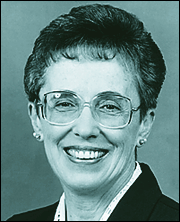

![]()
Gathering Places


![]()
Gathering Places
The aging of our society is becoming an increasing burden to those working in health care and social services. National policy analyst and pollster Frank Luntz has predicted that "this country will hit a wall in five years because of the long-term care problem and our consistent lack of commitment to the issues." Long-term care
problem requires
innovative approachesThe elderly population and others requiring long-term care are growing each day. The situation is different from that of 10 years ago because of the large increase in the numbers of the "frail elderly" -- that is, those 85 years-plus, who are at risk for disability.
Medical science enables people to live productive lives well into their 80s and 90s. But when a frail elder becomes ill or is no longer able to cope with daily living, the family he depends upon may also be elderly. Older people not only receive care but are called upon to provide care. The job of caregiver is often one of social isolation and stress, with the burden falling disproportionately upon older women. .
In Hawaii, our elderly population is growing at 2.5 times the national average. Yet, we have beds in nursing homes far below the national average of 53 beds per 1,000. The Executive Office on Aging says families in Hawaii will pay about $212.3 million for nursing home care by 2020, and will be forced to convert financial assets to pay for elder care.
Between 1991 and 2020, the Hawaii share of Medicaid expenditures for nursing home care will grow to $544.8 million. That Medicaid comes out of our taxes, both federal and state.
What can be done? Encouraging people to buy long-term care insurance and to provide tax credits will help but, according to the General Accounting Office, only 10 to 20 percent of older Americans can afford the premiums, which range from $900 to $2,400 per year. In addition, pre-existing conditions and disabilities disqualify some from coverage.
Not long ago, I traveled to Japan as a member of the U.S.-Japan Exchange on Women in Public Policy. There we discussed long-term care options with Japanese women to find out about "Kaigo-Hoken," the new program for long-term care. In this program, started last April, citizens begin paying into a government insurance program at the age of 40. The government pays 50 percent of the cost, which covers the cost of nursing home and community care; the cost of food is still a personal responsibility.
Hawaii has begun innovative programs such as Kupuna Care, using a Medicaid waiver to cover costs. (Normally Medicaid is used for institutional care.) The program is an attempt to keep elders at home as long as possible to avoid the costs of a nursing home.
In the Legislature this year, the House of Representatives appropriated $100,000 for the state auditor to conduct an actuarial study on Hawaii's long- term care needs. In addition, the budget includes monies for a feasibility study to be conducted by the Executive Office on Aging.
Meanwhile, we should look at other actions: 1) develop caregiver training and education; 2) provide respite to caregivers; 3) consider using underutilized schools as elder-care facilities when neighborhoods grow older; 4) plan to build another life into school buildings as long-term care and day-care facilities in the future.
Paul Saucier of the Muskie Institute of Maine advises legislators to "look at how their long- term care systems can be expanded to include people who can afford to pay for a portion of services themselves, and keep people from becoming dependent upon the Medicaid system."
He says: "Legislators need to direct state Health and Human Services to develop better information systems and hire analysts to study the data on long-term care." He advises states to give direction to departments on establishing standards so they can determine what works.
Finally, ethical issues related to long-term care will need to be discussed and resolved. Will technology, for example, continue to provide futile care to the terminally ill, while others who have potential for life languish for lack of adequate care? These are hard questions, but questions we need to begin looking at now.
Marilyn B. Lee , D-38th District (Mililani-Waipio),
is House Majority Floor Leader.